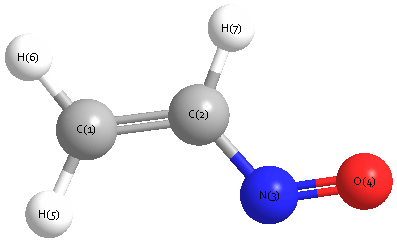Vibrational Frequencies calculated at TPSSh/STO-3G
| Mode Number |
Symmetry |
Frequency
(cm-1) |
Scaled Frequency
(cm-1) |
IR Intensities
(km mol-1) |
Raman Act
(Å4/u) |
Dep P |
Dep U |
|---|
| 1 |
A' |
3542 |
3542 |
1.36 |
43.66 |
0.73 |
0.84 |
| 2 |
A' |
3418 |
3418 |
0.30 |
69.13 |
0.17 |
0.30 |
| 3 |
A' |
3382 |
3382 |
25.13 |
25.05 |
0.25 |
0.40 |
| 4 |
A' |
1776 |
1776 |
5.75 |
14.67 |
0.14 |
0.24 |
| 5 |
A' |
1550 |
1550 |
7.69 |
6.64 |
0.13 |
0.22 |
| 6 |
A' |
1518 |
1518 |
8.46 |
37.44 |
0.37 |
0.54 |
| 7 |
A' |
1344 |
1344 |
0.45 |
7.72 |
0.71 |
0.83 |
| 8 |
A' |
1124 |
1124 |
29.84 |
13.89 |
0.70 |
0.82 |
| 9 |
A' |
861 |
861 |
43.08 |
0.72 |
0.69 |
0.82 |
| 10 |
A' |
540 |
540 |
0.34 |
5.19 |
0.32 |
0.49 |
| 11 |
A' |
302 |
302 |
0.04 |
0.38 |
0.70 |
0.82 |
| 12 |
A" |
1070 |
1070 |
15.03 |
0.08 |
0.75 |
0.86 |
| 13 |
A" |
998 |
998 |
12.68 |
0.14 |
0.75 |
0.86 |
| 14 |
A" |
585 |
585 |
0.58 |
4.49 |
0.75 |
0.86 |
| 15 |
A" |
140 |
140 |
0.66 |
0.99 |
0.75 |
0.86 |
Unscaled Zero Point Vibrational Energy (zpe) 11075.7 cm
-1
Scaled (by 1) Zero Point Vibrational Energy (zpe) 11075.7 cm
-1
See section
III.C.1 List or set vibrational scaling factors
to change the scale factors used here.
See section
III.C.2
Calculate a vibrational scaling factor for a given set of molecules
to determine the least squares best scaling factor.
Charges, Dipole, Quadrupole and Polarizability
Charges from optimized geometry at TPSSh/STO-3G
Charges (e)
| Number |
Element |
Mulliken |
CHELPG |
AIM |
ESP |
| 1 |
C |
-0.128 |
|
|
|
| 2 |
C |
-0.036 |
|
|
|
| 3 |
N |
-0.038 |
|
|
|
| 4 |
O |
-0.065 |
|
|
|
| 5 |
H |
0.094 |
|
|
|
| 6 |
H |
0.088 |
|
|
|
| 7 |
H |
0.084 |
|
|
|
Electric dipole moments
Electric dipole components in Debye
(What's a Debye? See section
VII.A.3)
| |
x |
y |
z |
Total |
| |
0.301 |
1.793 |
0.000 |
1.818 |
| CHELPG |
|
|
|
|
| AIM |
|
|
|
|
| ESP |
|
|
|
|
Electric Quadrupole moment
Quadrupole components in D Å
Polarizabilities
Components of the polarizability tensor.
Units are
Å
3 (Angstrom cubed)
Change units.
| |
x |
y |
z |
| x |
3.844 |
1.719 |
0.000 |
| y |
1.719 |
3.871 |
0.000 |
| z |
0.000 |
0.000 |
0.762 |
<r2> (average value of r
2) Å
2
| <r2> |
80.245 |
| (<r2>)1/2 |
8.958 |
